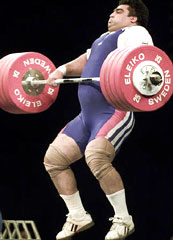Friday, March 28, 2008
Wednesday, March 26, 2008
Get Your Protein On!
What it means to me is that my typical in-training intake is way too low.
Monday, March 24, 2008
Friday, March 21, 2008
Thursday, March 20, 2008
Wednesday, March 12, 2008
Larry Mintz Memorial Weightlifting meet this Saturday
Be there!
Tuesday, March 11, 2008
Learning the Snatch: Backward Chaining
Backward chaining is one of the foundations of the Soviet Model for teaching the lifts. A sample progression, as recommended by former national team coach Alexander Medvedyev, would run something like this:
-Power snatch from hang position above the knees
-Power snatch from hang position below the knees
-Power snatch from the floor
From there, the progression to full snatch is forward chained:
-Power snatch from the floor
-Power snatch from floor to overhead squat
-Squat snatch from floor
It is also worth noting that the Soviet Model calls for learning the snatch before the clean. A topic for future discussion.
You gotta squat.
Friday, March 7, 2008
Wednesday, March 5, 2008
Arnold Classic 2008 Videos
Monday, March 3, 2008
Dinosaur Training

This is an old article I found on a page no longer hosted, so I had to find it using the way-back machine.
Basically an attempt to marry Dinosaur Style training with some Westside organization, it seemed a great take on lifting big for some real development in strength.
An outtake...
What I realized is that dinosaur training and the Westside system are much more similar than different. How so? Well,
Both emphasize heavy training. If I might quote the 2 'experts' of Westside and Dinosaur theory, Brooks Kubik says that "HEAVY weights are the name of the game. Never forget that. You need to train with heavy weights because doing so is the only way to build the strength of tendons and ligaments along with your muscles." Louie Simmons says that "We know best of all you have to train heavy-very heavy-and often."
Both camps dismiss the typical Western periodization, or cycling, model. Louie Simmons says that "It is my experience that all elements of training must be done simultaneously, or the training effects are lost very quickly", while Brooks Kubik feels that "Back-cycling to 60 or 70% of your max and then working back up is a waste of time. You are going nowhere. Most of your time is spent with poundages too light to test your abilities."
Both systems are devoted to exercises that are hard and heavy. Things like squats, deadlifts, zercher squats, front squats, bench presses, military presses, and reverse hyperextensions are lifts that build strength through compound movements. The exercises in each system are dedicated to building functional strength through a movement chain, not isolating each individual muscle group, unless that muscle group is a weak link. Similarly, because of the fact that training with machines is not as demanding as training with free weights, machines are not of prime importance in either system.
Both systems make use of particularly 'hard aerobics' as I like to call them. The sled dragging, wheelbarrow pushing, and walking lunges of the Westside system are very much like the sandbag carrying and farmer's walks of Dinosaur training.
DAY 1: Deadlifts, Front Squats, Bench Press, Bent-Over Rows, Bradford Press, Standing Calf, Seated Calf
DAY 2: OFF
DAY 3: OFF
DAY 4: Squats, Romanian Deadlifts, Close-Grip Benches, One-Arm DB Press, DB Extensions, Strict Curls, Grip Work
DAY 5: OFF
DAY 6: OFF
DAY 7: Speed Squats, Speed Bench, Power Cleans, Bent-Over Rows, Push Presses,Standing Calf, Seated Calf
DAY 8: OFF
DAY 9: OFF
Here's the archived version of the page. If anyone has info on the author, please share.





